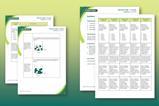Learning to answer long-form questions takes time and practice. Use these approaches to get your students to structure their responses within the time limit

Fortunately for us teachers, most assessment items in chemistry are quite short and each mark is fairly closely defined. We don’t have to mark pages and pages of prose and assess its level or suffer 25-mark essays that our colleagues in biology face. However, we do have one exception – the dreaded ‘six-marker’ in GCSEs. These specific extended response questions are marked by using levels of response, their focus is not only on the indicative content but also how the content is organised.
These questions may be extended calculations but more often, especially in the 14–16 age range, they involve written answers with command words like explain, compare and evaluate.
As a general rule of thumb in exams, one mark approximately equates to one minute of time spent on the question. Some questions are much quicker to tackle than that and so it’s reasonably safe to assume that around 8–10 minutes for a six-mark question is a good target. If you can bear to lose the learning time from your lesson or you have a spare form time session, get students to sit in silence for 10 minutes, it is an awfully long time!
Encourage alternative approaches
When faced with a page full of lines to write on, the temptation is to fill it with words. One key mistake made by students and teachers is to assume that the six marks’ worth of content needs to be written as continuous prose. In the past, quality of written communication — spelling, punctuation and grammar — mattered in assessments. The new extended response questions do not have this element, so lots of time can be saved by not framing the key points in full sentences. Bullet points, diagrams and flow charts are all excellent ways of answering these questions, they save time and show organisation of ideas in a far more obvious way than a long paragraph.
Encourage strategy
Paula Radcliffe doesn’t just get up and run a marathon, she has a strategy in which she tackles different parts of the race at a different pace. Similarly, exams aren’t 26.2 miles long but concentrating for 1.5–2h is challenging. Everyone has different strengths in approaching their exams. Some students need to answer a few shorter questions to warm themselves up before they tackle a more difficult question that requires a longer answer. Others will benefit from tackling long-form questions as soon as they sit down in the exam, when they are fresh and have a clear head (or just to get it out of the way). Encourage students to try different approaches when they take their various topic tests or mock exams.
Download this
An example question with model answers and teacher notes from the Education in Chemistry website: rsc.li/2Lh2RTH
Although developing exam strategies takes time, there is one strategic quick win. Students are so used to working on an A4 page that they often fold exam booklets back on themselves. Longer questions are often presented across a double-page spread with the data and instructions on one page and the lines to write on over the next page. Folding the exam booklets means students have to flip back and forth between the instructions and their answers, which slows them down and can lead to transcription errors. So make sure your students don’t fold the pages!
Practice is key and it serves two purposes
The first purpose of practice is the most obvious, to make sure students can answer the questions in the time they have available. Scaffold this practice by breaking it down into its key elements to help students build confidence. For example, begin by giving students all the indicative content they need so they concentrate only on writing the answer in the time available. Once they’re able to do that, perhaps combined with the use of bullet points, move onto retrieving the key knowledge. For students who find silence challenging, the use of a clicking kitchen timer can help focus their minds on their timings and is transferable to their study habits at home.
The second reason to practise is to help students feel secure in the habits they’re trying to practise. Under pressure, students tend to revert to approaches they feel are safe, even if they’re not necessarily effective. Getting them to abandon their old habits, such as filling the page with prose, takes lots of repetition and evidence of success. The more often they use alternative approaches and see that they fit the mark schemes, the more likely it is they will take those approaches in their final exams.














1 Reader's comment